
All images © by Roberto Piperno, owner of the domain. Write to romapip@quipo.it.
Notes:
Page revised in February 2025.

All images © by Roberto Piperno, owner of the domain. Write to romapip@quipo.it.
Notes:
Page revised in February 2025.
 SS. Silvestro e Martino ai Monti
SS. Silvestro e Martino ai MontiLinks to this page can be found in Book 7, Map A3, Day 2, View B8 and Rione Monti.
The page covers:
The plate by Giuseppe Vasi
Today's view
SS. Silvestro e Martino ai Monti
- Crypt and Roman structures
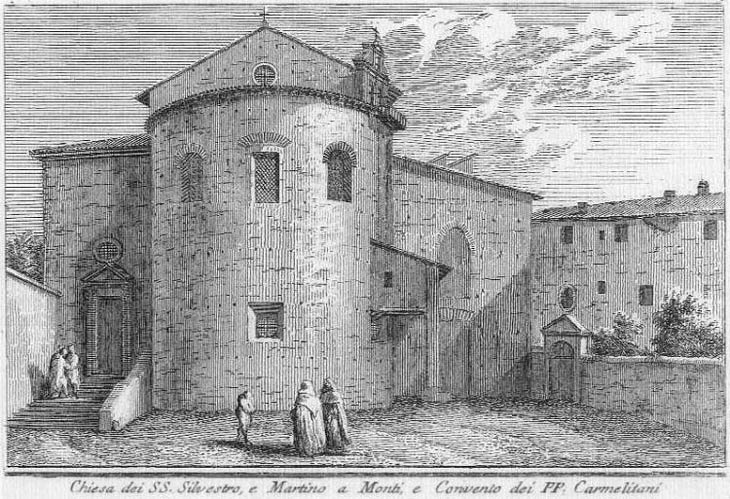
The earliest churches of Rome were either new constructions built on the sites where martyrs had been buried or the result of changes made to halls in private houses where the first Christians used to meet for prayer. Because the new faith spread rapidly among the ordinary people who lived on the Esquiline Hill, this neighbourhood retains some very old churches which in origin were private houses.
Giuseppe Vasi underlined the long history of SS. Silvestro e Martino ai Monti by showing its medieval apse rather than its XVIIth century façade.
The view is taken from the green dot in the small 1748 map here below which shows: 1) SS. Silvestro e Martino ai Monti and some of the other early churches in the area: 2) S. Maria Maggiore; 3) S. Prassede; 4) S. Pudenziana; 5) S. Pietro in Vincoli and 6) S. Lucia in Selci.


(left) The view in June 2009; (right) stones taken from the Servian walls which were used to level the ground
where the church was built
The level of the ground in front and at the side of the apse was lowered in the late XIXth century, thus some more steps were added to the staircase leading to the rear entrance to the church.

(left) Façade by Filippo Gagliardi; (right) detail portraying St. Sylvester
According to tradition a domus ecclesiae, a hall where the Christians met, was established in the house of a relative
of St. Sylvester, the Pope who is best known for the (forged) medieval document claiming that Emperor Constantine donated the City of Rome and the entire Roman Empire to him. Archaeologists believe that a nearby separate church was
dedicated to St. Martin of Tours; it is uncertain to which church the oldest parts of the current building belong.
During the IXth century a new church
dedicated to both saints was built above the ancient structures; the apse belongs to this period. In 1299 SS. Silvestro e Martino was assigned to the Carmelites; in the XVIIth century the church was largely renovated by Filippo Gagliardi, a painter aka
Filippo delle Prospettive because he usually worked with other colleagues and took care of the architectural perspectives of a painting (you may wish to see two of his works: a party at Palazzo Barberini and a view of the interior of S. Giovanni in Laterano).
The façade he designed for SS. Silvestro e Martino is rather traditional when compared to those of other Roman Baroque churches (you may wish to see the façade as it appeared in a 1588 Guide to Rome).
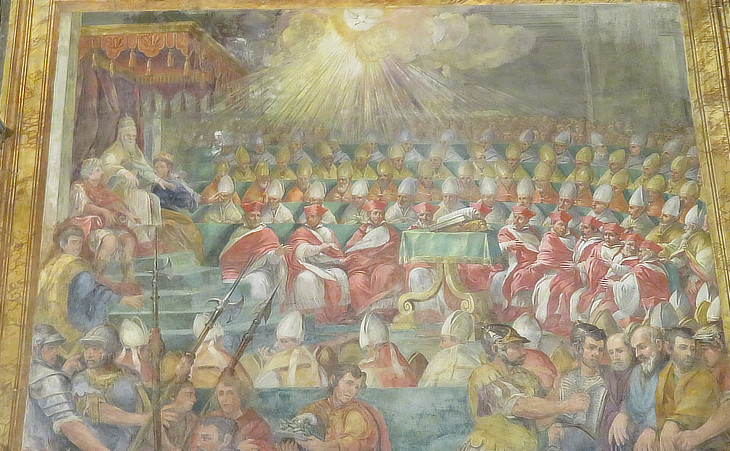
Inside the church: The Council of St. Sylvester by Galeazzo Leoncini (1640) with Emperor Constantine and St. Helena sitting at the sides of the Pope. Leoncini based his painting on images of the 1564 Tridentine Council
We know that the church dedicated to St. Sylvester was founded by St. Symmachus who was pope in 498-514, during the Ostrogothic rule over Italy. He was often in contrast with Byzantine Emperor Anastasius I and he claimed that Sylvester had presided over two ecumenical councils, including that at Nicaea, instead of Constantine, to support the viewpoint that the Pope had more authority than the Emperor in religious matters.
It has, as will easily be imagined undergone various repairs and is at present one of the most beautiful edifices in Rome. It is supported by Corinthian columns of the finest marbles, bearing not arches but an entablature, irregular indeed as to ornament, but of great and pleasing effect. (..) The tribune or sanctuary is raised several steps above the body of the church: the high altar which stands immediately above the steps is of the most beautiful form and richest material.
John Chetwode Eustace - A Classical Tour through Italy in 1802
During the renovation of the interior the Carmelites and Gagliardi decided to lower the floor of the church in order to increase
the visibility of the crypt which housed some relics; this explains why the ancient columns are placed above a pedestal;
the design of the medieval building which was based on that of a Roman basilica was retained, although the interior was entirely redecorated.

Detail of the frieze on the right side of the nave; the size of the capitals had to be adjusted to make up for the different height of the ancient columns
The decoration of the interior was in part assigned to Paolo Naldini, of whom the friezes of the nave are the first known work. He eventually worked with Gian Lorenzo Bernini who highly praised him for his stucco works. Naldini was commissioned the stucco decoration of S. Maria Assunta at Ariccia, but he also executed two of the marble angels at Ponte S. Angelo.
The friezes at SS. Silvestro e Martino depict symbols and scenes from the Old Testament (right side) and from the New one (left side).

Ceiling; (left) coat of arms of Pope Pius IV; (right) coat of arms of the Carmelites
The massive ceiling
is divided into compartments, and richly ornamented:
in the compartment over the door and in that at the
opposite extremity are the arms of S. Charles Borromeo, consisting of the word HUMILITAS crowned:
next to that near the door are the arms of the Carmelite Order: the next are those of Pius IV., in whose
time the ceiling was constructed at the expense of his
nephew, S. Charles Borromeo
Rev. Jeremiah Donovan - Rome ancient and modern - 1843.
Gagliardi redesigned the ceiling, but the main elements of the old one were included in a new frame;
the motto "humilitas" which can be seen in the image used as background for this page belongs to Cardinal Carlo Borromeo
who promoted the construction of the first ceiling in 1560. You may wish to see a page on the ceilings of the churches of Rome.

Frescoes by Gaspard Dughet (aka Gaspero Pussino): (left) Prophet Elijah anoints Azael to be king over Syria; (right) Basilides' (a monk living on Mount Carmel) Prophecy to Titus
The walls of the aisles are adorned with paintings by the two Poussin and much admired by connoisseurs. (..) The paintings on the walls and roof are coloured in the brightest yet softest tints imaginable and seem to shed over the whole church a celestial lustre. Eustace
Because Prophet Elijah had defeated the priests of Baal on Mount Carmel, the Carmelites commissioned Gaspard Dughet a series of frescoes showing episodes of the prophet's life. Dughet, a relative and a pupil of Nicolas Poussin, the famous French painter who spent most of his life in Rome, specialized in painting landscapes of the Roman countryside (see those he painted at Palazzo Pamphilj at Valmontone). In his frescoes at SS. Silvestro e Martino he gave more relevance to clouds, mountains and trees than to the prophet's deeds, similar to what was done before him by Polidoro da Caravaggio at S. Silvestro al Quirinale and Tarquinio Ligustri at S. Vitale.
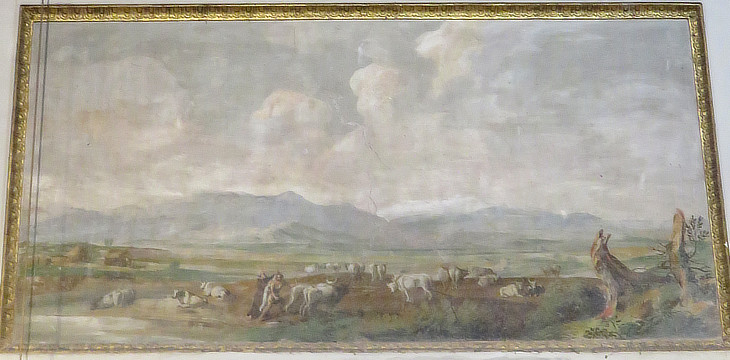
Fresco by Dughet: Elijah throwing his mantle over Elisha who was ploughing with twelve yokes of oxen
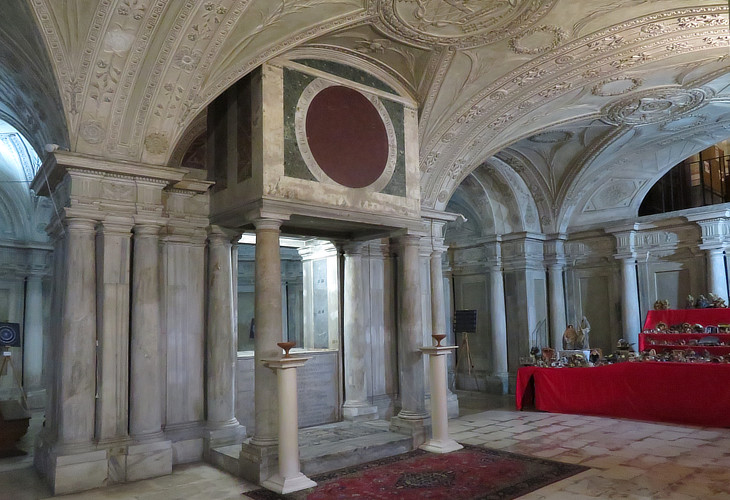
Crypt with a suspended marble urn containing the relics of martyrs which were moved to the church from the Catacombs of St. Priscilla in the IXth century
Under the altar a door opens upon a marble staircase leading to a subterraneous chapel lined with stucco, nearly resembling marble, and adorned with numerous pillars in a very pleasing style of architecture. Eustace
At the extremity of the church, near the
tribune, are three flights of white marble steps, two
at the sides, leading up to the great altar, and one
in the centre leading down to a modern oratory. Donovan
In 1656 Filippo Gagliardi was elected Prince of the Accademia di San Luca, but his fame waned after his death and for a long time the design of the crypt was attributed to Pietro da Cortona, a leading painter and architect of the XVIIth century, because of its similarity with Cortona's interior of SS. Luca e Martina.
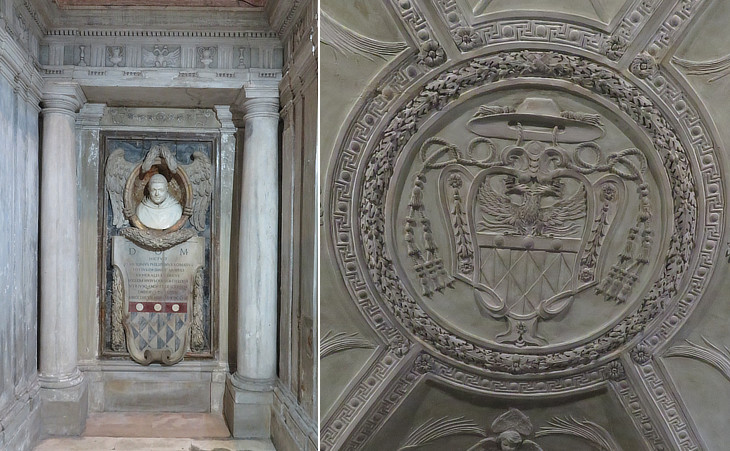
Crypt: (left) Monument to Giovanni Antonio Filippini, General of the Order, by Paolo Naldini; (right) stucco coat of arms of Filippini on the ceiling
P. Filippini, General of the Order, expended on the decoration of the church upwards of
70,000 scudi, equal to 15,000 pounds, his hereditary
property. (..) Descending by the middle stairs into the oratory we find, affixed to the wall to our right, a slab with a list ot the relics contained in the church. Donovan
The restoration and redesign of the church was promoted and paid for by Giovanni Antonio Filippini, who wrote a book on the history of the church and its antiquities (Ristretto di tutto quello che appartiene ali'antichita e veneratione della chiesa de' SS. Silvestro e Martino de'
Monti, Rome, 1639. The redesign of the main part of the church appears not to have been finished before 1650. Work on the crypt probably began in that year and was finished in 1655. The monument to Filippini follows a typical pattern with a bust of the dead inside a medallion, which in this case is placed inside his heraldic symbols (see the same approach in a monument at S. Maria del Popolo).
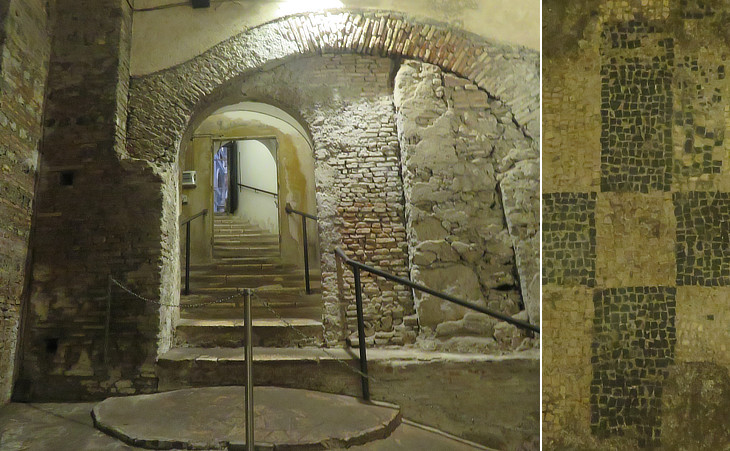
(left) Hall of the underground Roman building; (right) part of a floor mosaic
Thence you pass into the ancient church, which, from the increase of the ruins around is now become almost subterranean: it is a large vaulted hall, once paved with mosaic, and seems from the remains, to have been well furnished with marble and paintings; it is now the receptacle of damp unwholesome vapours, that tinge the walls, and hover round the solitary tombs. (..) The spectator, cautioned by the chillness of the place not to prolong his stay, contents himself with casting a transient glance on the sullen scenery, and returns to the splendid exhibition of the temple above. Eustace
Beyond the monument of P. A. Filippini is the entrance
into the ancient church, the alternate scene of Imperial luxury and primitive piety. It consists of a nave
and two aisles; was floored with mosaics, as is still
seen; and has a large cross painted in the centre
of its ceiling. Donovan
The adjoining Roman building above which the medieval monastery was built,
is oriented obliquely to the basilica. It is a brick-faced concrete structure dating originally
from the early years of the IIIrd century. The nucleus of the building is a rectangular hall roofed
with cross vaults which are supported on piers attached to the perimeter walls and on two central
piers. The vaulting thus divides the hall into six bays. The layout suggests that the building was a storehouse, perhaps an ancillary facility of the nearby Terme di Traiano.
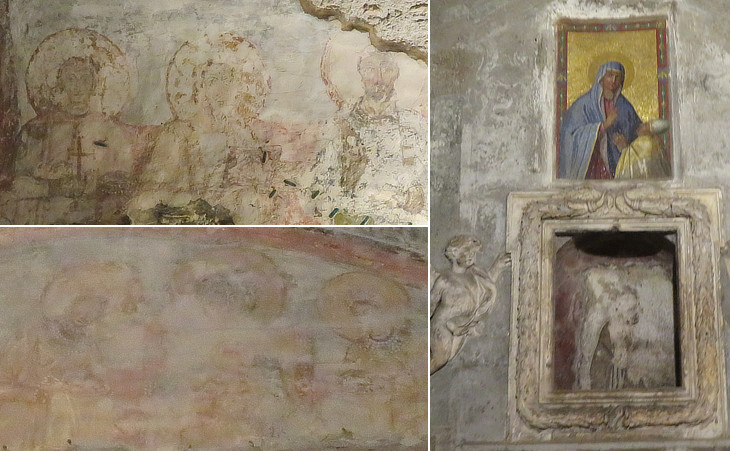
(left-above) St. Processus, St. Paul and Jesus Christ; (left-below) St. Irene (Peace), the Virgin Mary and St. Agape (Charity); (right) mosaic portraying the Virgin Mary and St. Sylvester and a 1630 copy of it
On its altar (it has but one), in
a glazed recess, is an ancient image of the B. V.
with S. Sylvester praying at her feet, in mosaic,
much consumed by time; and over the recess is a
copy of the same also in mosaic. Donovan
In the early Christian stage brickwork walls were added to provide additional space for paintings. We may suppose that, similar to S. Maria Antiqua, the walls were covered with frescoes, which have almost entirely disappeared because of dampness.
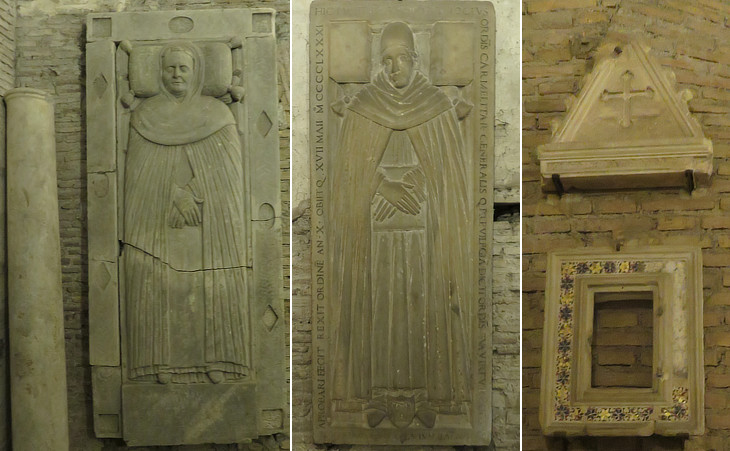
Underground area - works of art from the medieval church: (left) tombstone of a General Prior of the Carmelites; (centre) 1481 tombstone of General Prior Cristoforo Martignoni; (right) decorative fragments
Next plate in Book 7: Chiesa di S. Gregorio e Monastero dei Monaci Camaldolesi.
Next step in Day 2 itinerary: Chiesa e Monastero di S. Lucia in Selci.
Next step in your tour of Rione Monti: Chiesa e Monastero di S. Lucia in Selci.
Excerpts from Giuseppe Vasi 1761 Itinerary related to this page:
Chiesa di S. Martino ai Monti
Uscendo dalla porta maggiore della riferita chiesa, e camminando a destra, si ritrova a sinistra un gran cancello di
ferro, che corrisponde alla tribuna di questa antichissima chiesa. Da Costantino Magno si crede comunemente
essere stata eretta nelle terme di Trajano ad istanza di s. Silvestro Papa, il quale vi celebrò un Concilio di 286.
Vescovi, e si vede ancora nel sotterraneo l'antica sedia Pontificale fatta di marmo, e un'immagine della santissima
Vergine fatta di mosaico in quei rozzi tempi; e per le muraglie, e volte si ravvisano, ancorchè mal ridotte, le immagini
sagre colla Croce. Dopo varj ristauramenti fu conceduta ai frati Carmelitani, e nel tempo, che ne fu Titolare s. Carlo
Borromeo, vi fece il soffitto dorato; dipoi il Card. Gabbriello Paleotti il coro, Paolo Santacroce l'altre maggiore, e
finalmente il P. Filippone Generale di quell'Ordine ripulì le colonne della nave, e fecevi delli stucchi, e pitture. Tutte le
statue sulla cornice sono di Paolo Naldino, fuorchè il s. Antonio, ed il s. Gio: Batista, che sono di un Fiammingo; il
quadro di s. Stefano contiguo alla porticella, per cui siamo entrati, è di Giovanni Agostino Canini; il s. Martino è di
Fabbrizio Chiari; quello di s. Teresia, del Greppi, e la s. Maria Maddalena de' Pazzi, di Bartolommeo Palombo. Il
quadro del Battesimo di Gesù Cristo è del suddetto Chiari; il battesimo di s. Cirillo è di Gio: Miele Fiammingo; il s.
Angelo Carmelitano, di Pietro Testa, ed il s. Alberto del Muziano. Passata la porta della sagrestia, il quadro nell'altare
maggiore, con s. Bartolommeo è del Canini, ed il quadro nell'ultima cappella è di Girolamo Maffei. Il s. Silvestro, e s.
Martino vescovo posti ai lati dell'altare maggiore sono del Baglioni; la tribuna, come anco il concilio dipinto presso la
sagrestia sono del Galeazzo, e li paesi sono di Gaspero Pussino celebre pittore Francese, fuorchè li due grandi, che sono
a lato dell'altare di s. Maria Maddalena de' Pazzi, perchè fatti da Gio: Francesco Bolognese. |

